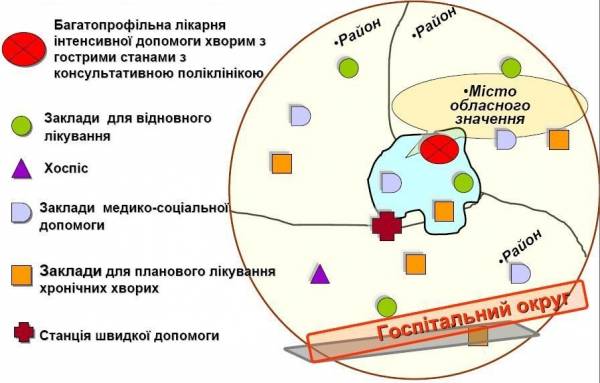
In 2017, Ukraine will fundamentally change the health care system. One of the most important stages of health reform is the creation of hospital districts, which completely pereformuliruem the relationship between patients and medical institutions. This topic has caused quite a stir in the society and managed to acquire many myths, writes “Obozrevatel”.
Myth 1. District hospital forms the Ministry of health
In fact, the geographical boundaries of the districts offer local authorities, and the government only approves.
The health Ministry explained that the hospital district is created to organize a network of health facilities that provide specialized care. Thus, in each district hospital will have at least one hospital intensive care, equipped with all necessary equipment to provide specialized medical care round the clock. The distance to this hospital should be set up so that people could drive there in an hour. Also the hospital district must cover at least 120 thousand people.
This is the only requirement put forward by the Ministry of health to the formation of hospital districts. All other issues are addressed at the community level: what should be the network of medical institutions in the district hospital, which hospitals should restructure, and which medical facilities to create additional, as patients will be able to drive it, what roads you need to renovate or build.
Myth 2. Because of the creation of hospital districts will close hospitals
Actually this does not happen, because we can only talk about their conversion. That is, instead of a low-power, minimally loaded and poorly equipped hospitals will be created in other hospitals (rehabilitation centres for combatants, diagnostic centers, hospices, etc.). And the best hospitals will be further technically and personnel reinforced that every resident of the County had the opportunity to receive quality medical care.
 Graphics: Likar.info
Graphics: Likar.info
However, what medical facilities need to restructure, will be settled exclusively by the local community. In particular, its representatives should create a Hospital Board. By the end of 2017, this body will develop a district plan for five years, and will adopt its local Council. The document clearly defines the network of health facilities, routes patients, as well as the amount of investment needed to equip hospitals with modern equipment.
Myth 3. People are deprived of access to health care
The government assured that thanks to the streamlining of the network of medical institutions, which will take place in development districts and the availability of quality treatment for the citizens is expected to increase.
Now in Ukraine there are dozens of hospitals, where doctors operate on at least 500 patients a year, while, for example, in Finland, Germany and the UK the figure is not less than 4 thousand. The Ministry of health are convinced that to be treated in hospitals malonarushennye dangerous, as a doctor, which is not good practice, loses skills and is unable to provide quality care to the patient.
However, officials expect that after the creation of hospital districts in each of them will be at least one powerful hospital of intensive treatment with continuous operation, seven days a week.
Myth 4. In the field, you can create an unlimited number of hospital districts
First of all, you should know that the offer of local authorities in the number of hospital districts in the field should correspond to the practical needs and capacities of communities.
The transition to the new system of health financing implies that money will follow the patient. That is, the amount of funding from the budget for the hospital depends on the number of patients who received in her medical care. And if hospitals will not have a sufficient number of patients, that local authorities would have to find funds for their maintenance and a decent salary for doctors. Moreover, the medical institutions with poor facilities and incompetent doctors simply will not go to patients.
In this regard, communities must agree in advance about what will be the network of medical institutions in the district, based on its real needs. The Ministry of health also draw attention to the fact that the local authority needs to clearly set the priorities and decide what is more important: for example, to keep a small hospital in the village or to repair the road to the district center and quickly deliver patients.
Myth 5. District hospital it is impossible to create prior to the completion of the administrative-territorial reform
The formation of hospital districts does not depend on the administrative-territorial reform and the process of formation of unified territorial communities, since the hospital district is not a level of government, entity or enterprise.
It’s just a tool of cooperation of communities to make decisions at the institutions of secondary medical care among the cities of regional value, district, and United local communities, which now need to effectively manage their property (hospitals) to organize a network of medical institutions and improve the quality of assistance. Faster than at the local level will be resolved all of these issues, the faster the government will provide the necessary support and resources.
The head of the government Volodymyr Groysman also assured Ukrainians that the ultimate goal of healthcare reform is not closing hospitals on the ground, and the creation of a unified network of institutions, where citizens will receive medical care regardless of the region in which they live.
“The creation of hospital districts is the question of local authorities which they must decide, given the characteristics of the region. If we say that in each district should be the hospital’s second level, it is unlikely that she will be professional. We need to have in case of contact with the hospital, urgent or planned, people received quality care the second level. With regard to primary care medicine, it is necessary to bring to people. Prevention of diseases, their early detection is an important element of primary care medicine,” he explained.







